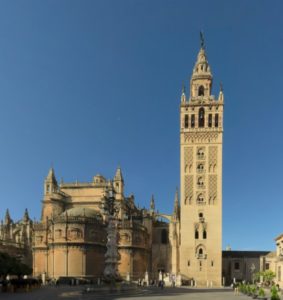By Greg Dreyer, Class of 2007
During a tour Spain in 2016, I was impressed with the La Giralda tower attached to Seville’s cathedral. Remembering the homework essays from docent training, I found myself comparing and contrasting Chicago’s Wrigley Building with this architectural treasure.
Designed by Charles G. Beersman of the architectural firm Graham, Anderson, Probst & White, the Wrigley Building was constructed between 1919 and 1924. Designed in the European classical tradition with French/Spanish influences, it was inspired by La Giralda tower. While not a replica of La Giralda, both structures are five-tiered towers. The bottom three tiers are rectangular while the top two are rounded. And in the spirit of the Spanish Renaissance style, both towers make liberal use of finials.
At 331 feet, La Giralda is shorter than the Wrigley, which tops out at 398. It is attached to Seville’s Cathedral, the third largest church in the world. La Giralda means “weather vane” and indeed, there is a weather vane on top of the tower. And it also functions as a bell tower, while the Wrigley Building serves as a clock tower.
La Giralda was originally built as the minaret for the Great Mosque of Seville. It was completed in 1198, when the Moors ruled Spain and reflects the Arabic style of ornamentation. Recovered by the Christians in 1248 during the Christian Reconquest (known as the “Reconquista” in Spanish), the mosque was then converted to a cathedral. Damaged by an earthquake in 1356, Seville began building the current cathedral in 1433. It was completed 73 years later, in 1506. The new cathedral incorporated La Giralda as its bell tower. In 1568 the height was extended with the Renaissance style of ornamentation typical of the time. That ornamentation includes elements of the Italian Renaissance, Moorish, and Gothic styles.

The ornamentation of this historic structure symbolizes the Moorish control in Seville, the Christian Reconquest, the Inquisition, and the Renaissance. Seville is also located near Palos de la Frontera, the launching site of Christopher Columbus’s first voyage to the New World. As Columbus’s tomb is located in the Seville Cathedral, La Giralda also provides a symbolic connection between Spain and the New World.
European revivalist styles were very popular in American architecture during the late 19th and early 20th centuries, including the Spanish Renaissance Revival style. I speculate that the historical importance of La Giralda and the Columbus connection could have influenced the architects that designed other buildings in the United States. The World’s Columbian Exposition of 1893 celebrated the landing of Columbus in the New World and perhaps was in the mind of Chicago’s architects in the years after the fair.
La Giralda inspired not only our Wrigley Building but also these American buildings:
- The Tower at Madison Square Garden, New York, 1890, by McKim, Mead and White. Demolished in 1925, it was the first building in the U.S. inspired by La Giralda. In turn, its success inspired other buildings.
- Ferry Building, San Francisco, 1898
- Electric Tower, Buffalo, 1901
- Dreamland Tower, Coney Island, 1904 (destroyed in a 1911 fire)
- Freedom Tower, Miami, 1925
- Country Club Plaza, Kansas City, 1967 (most faithful to the original design, but half the size)
- Biltmore Hotel, Coral Gables, Florida, 1926
- Texas Tech University Administration Building, 1927, Lubbock, Texas
- Terminal Tower, Cleveland, 1926
CLICK HERE to view photos of buildings inspired by La Giralda.
Sources:
http://www.designing-america.com/contenido/the-voyages-of-the-giralda/?lang=en




Thanks Greg, I wanted to see the Seville tower for myself someday but you saved me the trip. Excellent information!
Nice article Greg. It provides much insight into the original tower land our similar one.
Thanks, Greg. This really gives us so much to say about a building that is on a number of tours. Now we just have to dissect your article and figure out which parts of what story will go into our River Cruise patter, Walk Through Time or Food and Architecture 1893. It’ll be a fun job.
Greg
Nice to see that the architecture of the building has a bit more clarification. The combination of Spanish Gothic and Moorish is called Moresco. Here is the reference: Smith, T. Roge. Architecture Gothic and Renaissance Kindle Edition location 2438. T Roger Smith is regarded in Europe as one of the leading authorities on Gothic Architecture. This book is essentially his lecture series.
Thanks, Tom! There is always more to learn!